�
目錄
Introduction
Understanding HoloLens
Hologram
Hardware detail
HoloLens shell overview
App views on HoloLens
Using mixed reality capture
Working with accessories
Developing for HoloLens
Development overview
App Model
Install the tools
Using Visual Studio
Using the HoloLens emulator
Using the Windows device portal
Known issues
Testing
Building blocks of Holographic apps
Gaze input
Gesture input
Voice input
Spatial Sounds
Building 2D apps
Building 2D apps
Building holographic apps with Unity
Unity development overview
Camera in Unity
Gaze in Unity
Gesture in Unity
Voice input in Unity
1.1
1.2
1.2.1
1.2.2
1.2.3
1.2.4
1.2.5
1.2.6
1.3
1.3.1
1.3.2
1.3.3
1.3.4
1.3.5
1.3.6
1.3.7
1.3.8
1.4
1.4.1
1.4.2
1.4.3
1.4.4
1.5
1.5.1
1.6
1.6.1
1.6.2
1.6.3
1.6.4
1.6.5
2
World anchor in Unity
Persistence in Unity
Spatial sound in Unity
Spatial mapping in Unity
Shared holographic experiences in Unity
Locatable camera in Unity
Keyboard input in Unity
Recommended settings
Tracking loss in Unity
Building holographic apps with Vuforia
Vuforia development overview
Getting started with Vuforia
1.6.6
1.6.7
1.6.8
1.6.9
1.6.10
1.6.11
1.6.12
1.6.13
1.6.14
1.7
1.7.1
1.7.2
3
�
Introduction
Introduction
本书的主要内容来自微软官方文档和笔者个人博客,其中多有不准确的地方,欢迎大家反
馈。
Weibo: @msp的昌伟哥哥
E-mail: mantgh@outlook.com
文章持续更新地址:博客园以及Gitbook
4
�
Hologram
Hologram 全息图像
HoloLens使我们可以通过周边世界的光线和声音来创建全息场景和物体,使得它们像真实物
体那样。全息场景能够响应你的凝视、手势和语音指令,同时还会和你周边世界的表面交
互。借助全息场景,你可以在周边世界创建数码物体。
光线声音构建的全息场景 A hologram is made of light and
sound
HoloLens渲染的全息场景会直接出现在用户的眼前,全息场景会投射光线到你的世界,这意
味着你同时会看到来自显示器的光线和环境光。HoloLens不会从你的眼睛移除光线,所以无
法使用黑色来渲染画面。取而代之的是,黑色内容会被渲染成透明内容。
全息场景有很多不同的表现和行为。一些看起来是真实的和实体的,另一些则看起来是卡通
的和空虚的。全息能够突出环境中的特性,这些特性能够成为全息应用中的用户界面元素。
5
�
Hologram
全息场景同样可以制造声音,这些声音会从你的周边环境中特殊的地方出现。在HoloLens
上,声音来源于耳朵上方的两个扬声器,同时扬声器不会覆盖耳朵。和显示器类似,声音是
附加的,这会引入新的声音而不会阻挡环境的声音。
全息场景能够在真实世界被放置或者跟随你 A hologram can be
placed in the world or tag along with you
当你想把全息场景放置到一个偏爱的位置,HoloLens能使你准确的在真实世界中放置它们。
当你绕着全息场景走动时,它会始终保持着和真实世界相对的位置。当你使用空间锚点来将
物体插入现实世界中,当你回来的时候,HoloLens甚至可以记得你留下它的位置。
6
�
Hologram
一些全息场景会跟随用户移动,它们始终保持着相对用户的位置,不管他们走动到哪里。你
甚至可以先选择一个全息对象跟着你移动,一旦到了另外一个房间后再将它放置到墙上。
全息场景能和你以及你的世界交互 A hologram interacts with
you and your world
全息场景不仅包括光线和声音;它们同时是世界中活跃的一部分。凝视一个全息物体并配合
手势,你可以使它跟随你。对全息场景发出语音指令,他也能响应你。
7
�
Hologram
全息场景能够确保用户个人的交互,因为HoloLens知道你的位置,所以当你在房间走动时,
全息的角色能够始终直视你的眼睛。
HoloLens也能和环境交互。例如,当你在桌上放置一个全息弹球,然后虚按它,能够观察到
球的弹跳和听到弹球与桌面撞击发出的声音。
全息图像也能被现实世界的物体遮挡。例如,你可能会看到一个全息角色走过一道门,进入
墙后面,走出你的视线。
全息图像就是我们梦想的东西 A hologram is whatever you
dream up
作为一个全息开发者,你有能力在2D屏幕外和真实世界中爆发你的创造力。
8
�



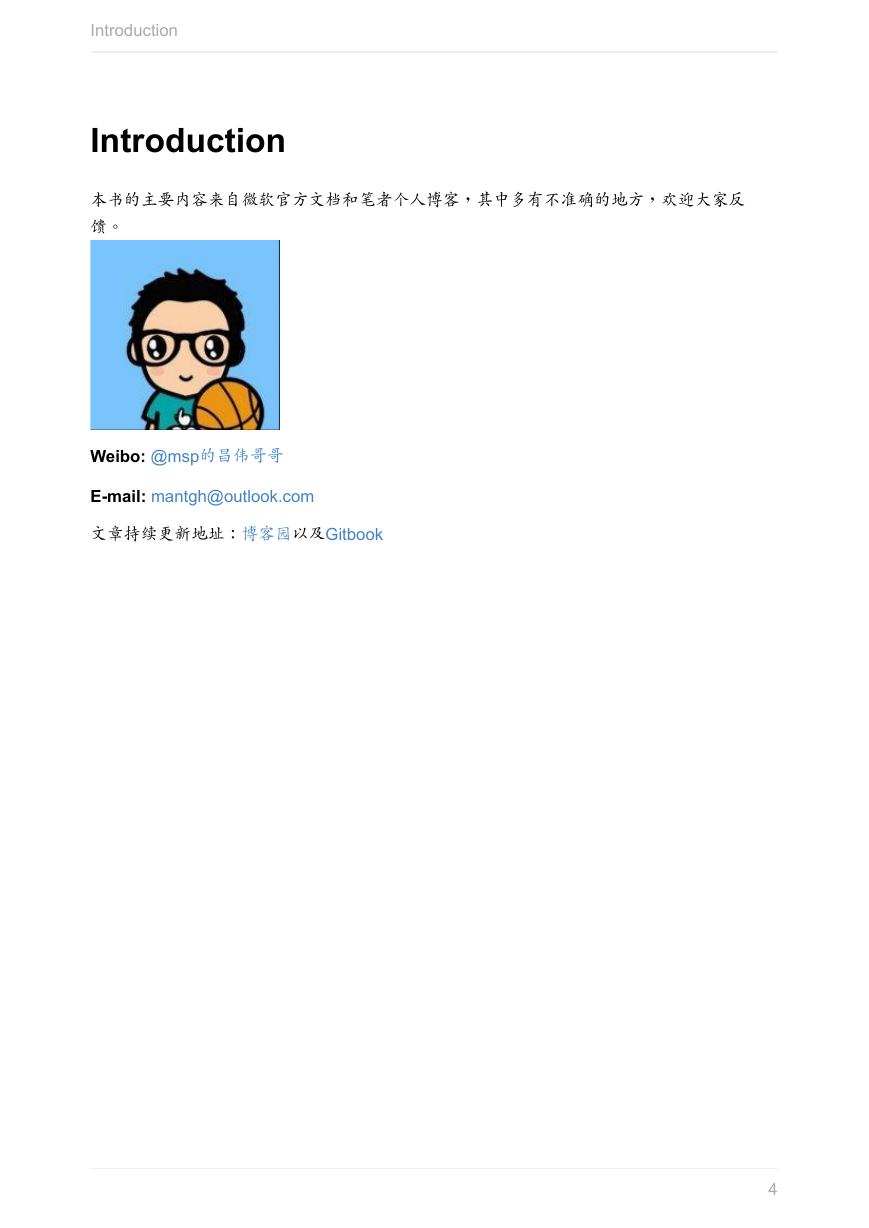
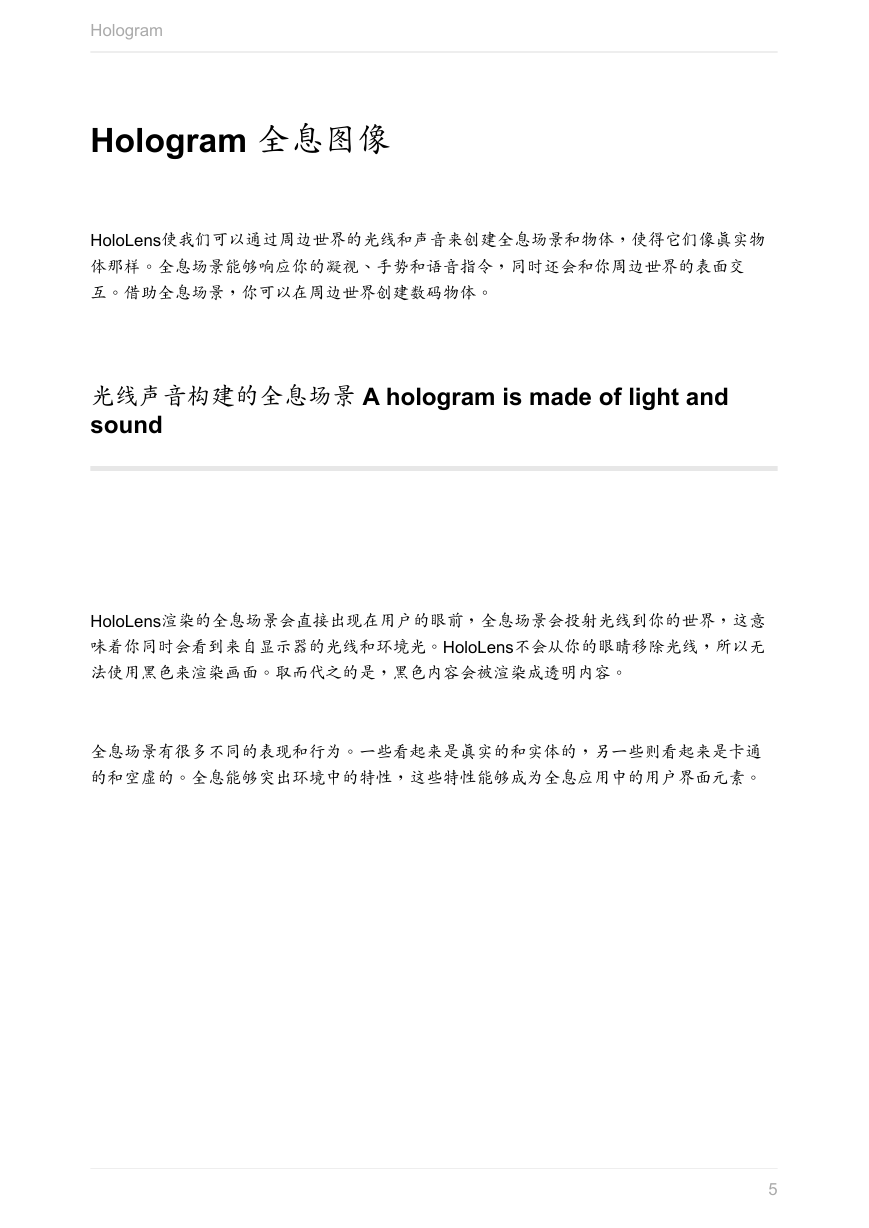
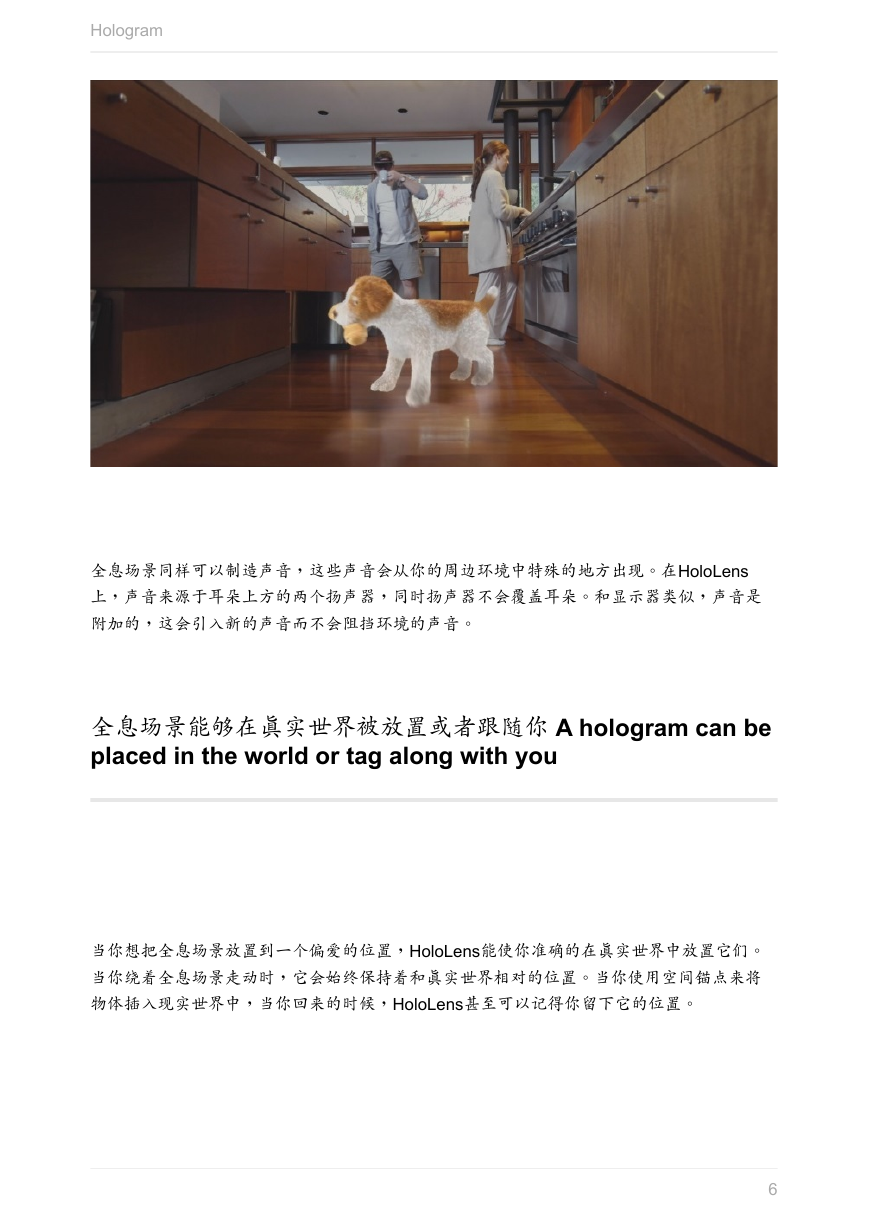
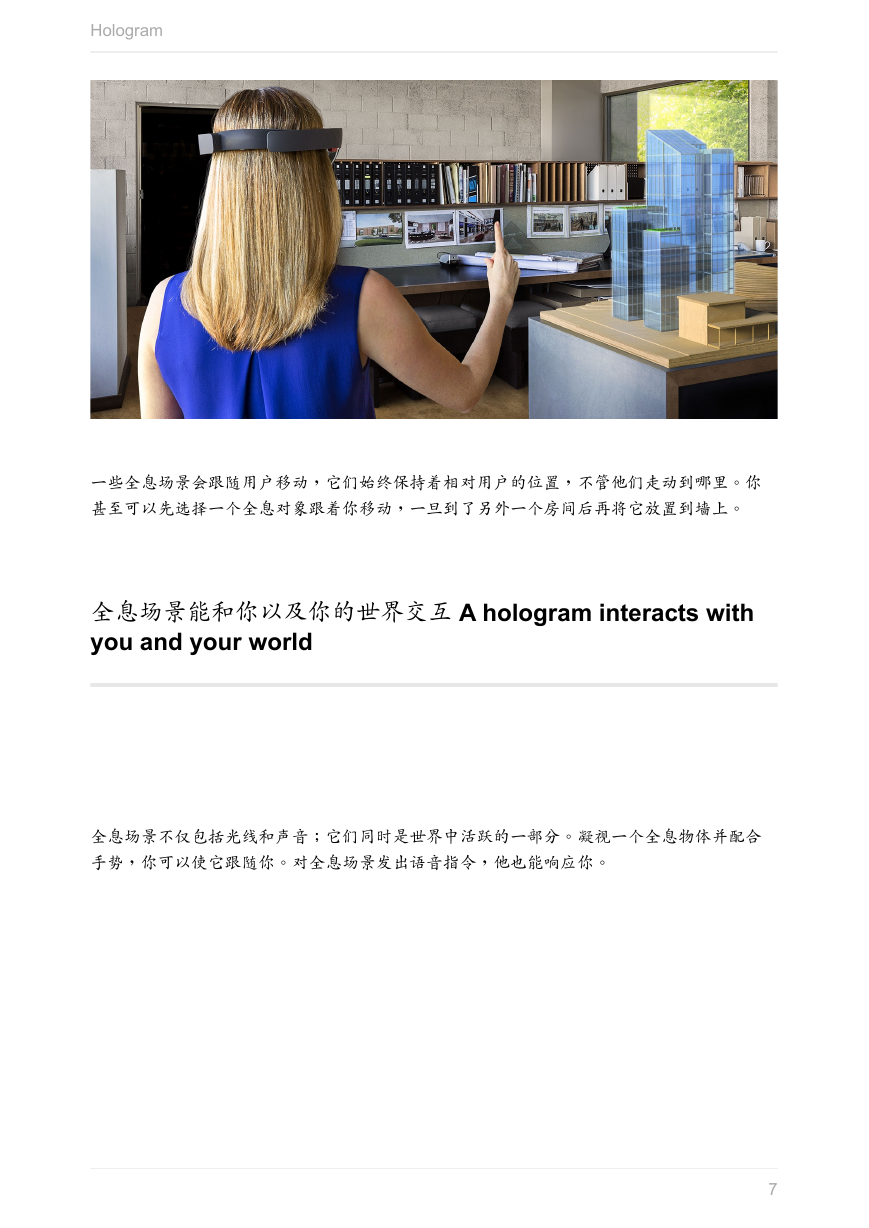
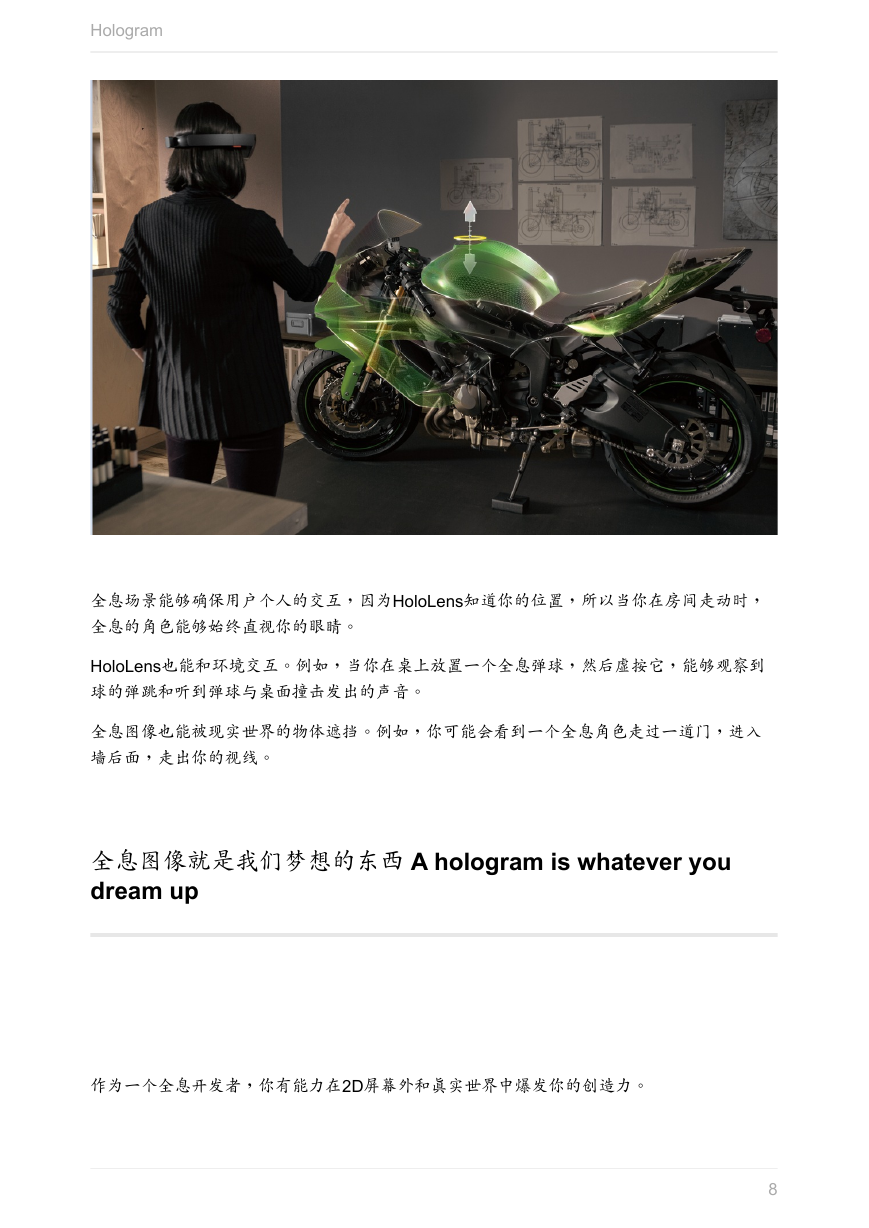








 2023年江西萍乡中考道德与法治真题及答案.doc
2023年江西萍乡中考道德与法治真题及答案.doc 2012年重庆南川中考生物真题及答案.doc
2012年重庆南川中考生物真题及答案.doc 2013年江西师范大学地理学综合及文艺理论基础考研真题.doc
2013年江西师范大学地理学综合及文艺理论基础考研真题.doc 2020年四川甘孜小升初语文真题及答案I卷.doc
2020年四川甘孜小升初语文真题及答案I卷.doc 2020年注册岩土工程师专业基础考试真题及答案.doc
2020年注册岩土工程师专业基础考试真题及答案.doc 2023-2024学年福建省厦门市九年级上学期数学月考试题及答案.doc
2023-2024学年福建省厦门市九年级上学期数学月考试题及答案.doc 2021-2022学年辽宁省沈阳市大东区九年级上学期语文期末试题及答案.doc
2021-2022学年辽宁省沈阳市大东区九年级上学期语文期末试题及答案.doc 2022-2023学年北京东城区初三第一学期物理期末试卷及答案.doc
2022-2023学年北京东城区初三第一学期物理期末试卷及答案.doc 2018上半年江西教师资格初中地理学科知识与教学能力真题及答案.doc
2018上半年江西教师资格初中地理学科知识与教学能力真题及答案.doc 2012年河北国家公务员申论考试真题及答案-省级.doc
2012年河北国家公务员申论考试真题及答案-省级.doc 2020-2021学年江苏省扬州市江都区邵樊片九年级上学期数学第一次质量检测试题及答案.doc
2020-2021学年江苏省扬州市江都区邵樊片九年级上学期数学第一次质量检测试题及答案.doc 2022下半年黑龙江教师资格证中学综合素质真题及答案.doc
2022下半年黑龙江教师资格证中学综合素质真题及答案.doc